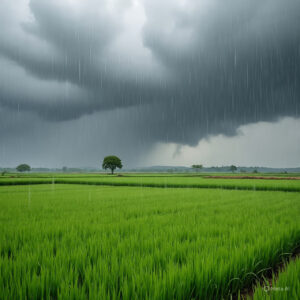Sowing with Storms: How Monsoon Surge Make or Break Harvests
June and monsoons have always tagged along. Moreover, it is not just monsoon, it is followed by a surge in sudden intense increase in clouds, winds with heavy rainfall.
These surges are often driven by changes in atmospheric pressure patterns and oceanic conditions. Some countries like India, Bangladesh, Nepal, Sri-Lanka, and some of Southeast Asia depend on the monsoon for their crops but are often heavily influenced by monsoon behavior in the calamity perspect.
Around 60%-70% of Indian Agriculture is mostly rain-fed; agricultural land or crops that depend entirely on natural rainfall for water rather than an irrigation system.

Science behind Monsoon Surges:
Monsoon is usually caused by changes in the Indian Ocean Dipole (IOD), El Nino-Southern Oscillation (ENSO), and Madden-Julian Oscillation (MJO).
The India Ocean and the sea surface have warm temperatures and low-pressure areas over any other subcontinent. Pulling moist Air inland, resulting in rainfall. Sudden drops in pressure or cyclonic circulations can also cause monsoon surges.
There are various types of monsoons, such as :
- Active Phase – when there is strong rainfall and the cover is with clouds
- Break Phase – when the monsoon is weak and it reduces the rainfall
Surges are the ones that can revive the weak monsoon or can trigger extreme rainfall.
It’s Various Impact On Agriculture:
Positive Impact –
- It increases the soil moisture, which boosts the growth of rain-fed crops like rice, pulses, and cereals.
- It recharges the groundwater, which improves the irrigation availability for the Rabi (Winter) season.
- Helps in reducing is cost of irrigation, which makes it less dependent on tube wells and electricity/diesel for pumping water.
Negative Impact –
- There is flooding in the field, resulting in waterlogging, which damages standing crops, especially in paddy fields specially in sugarcane, cotton, and vegetables.
- Soil erosion and nutrient runoff, and topsoil gets eroded, and essential nutrients get washed away.
- It delays sowing and harvesting, and excess rainfall can delay crop cycles.
- Crop disease and pests cause high humidity and stagnant water increases fungal diseases like blast in paddy and pest infestations.
- After the monsoon, there are past harvest losses as there is difficulty in drying and storing grains during monsoon surges.
Economic Consequences :
- Loss of Yield and income. Even a 5-10% drop in monsoon rainfall can lower national farm output significantly
- Price volatility in when there is a shortage of supply, which causes spikes in food prices, especially vegetables, pulses, and oilseeds.
- Insurance claims increase in payouts under schemes like PMFBY ( Pradhan Mantri Fasal Bima Yojana).
- Government Expenditure relief packages, minimum support prices (MSP), and import of food grains increase fiscal pressure.
Future Outlook :
- IPCC reports and suggests monsoon surges may become more intense but erratic.
- Deliver real-time insights to farmers through dashboards and mobile alerts
- Let’s shift to water-efficient crops and integrated farming practices.
However, monsoons would never stop coming, but we can prepare with better forecasting, smart farming practices, and resilient infrastructure through which their negative impact can be mitigated. With technology integrated response can be a key to turning monsoon variability into an opportunity rather than a crisis. For more latest updates, check Industrial Front.
